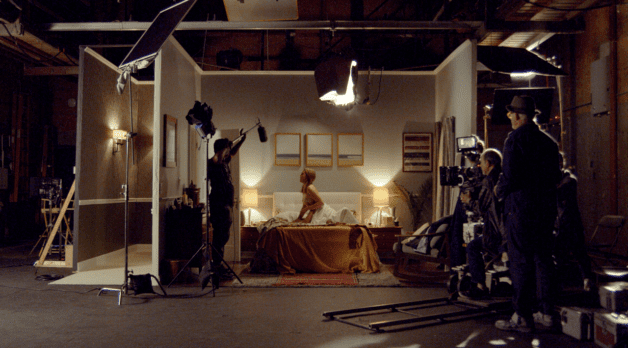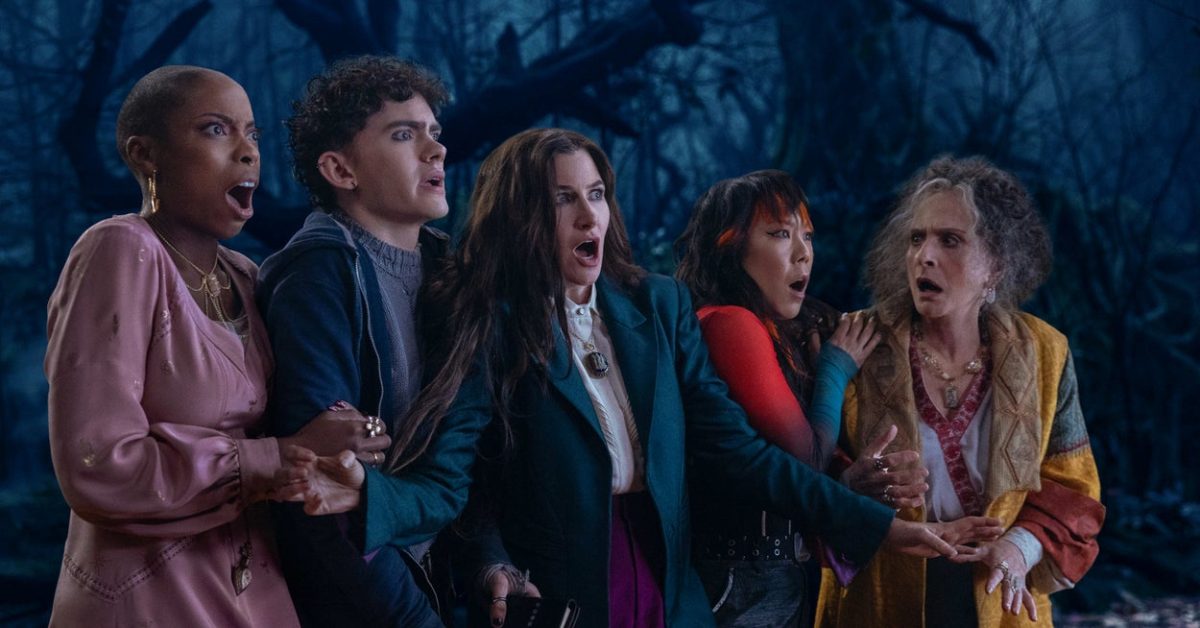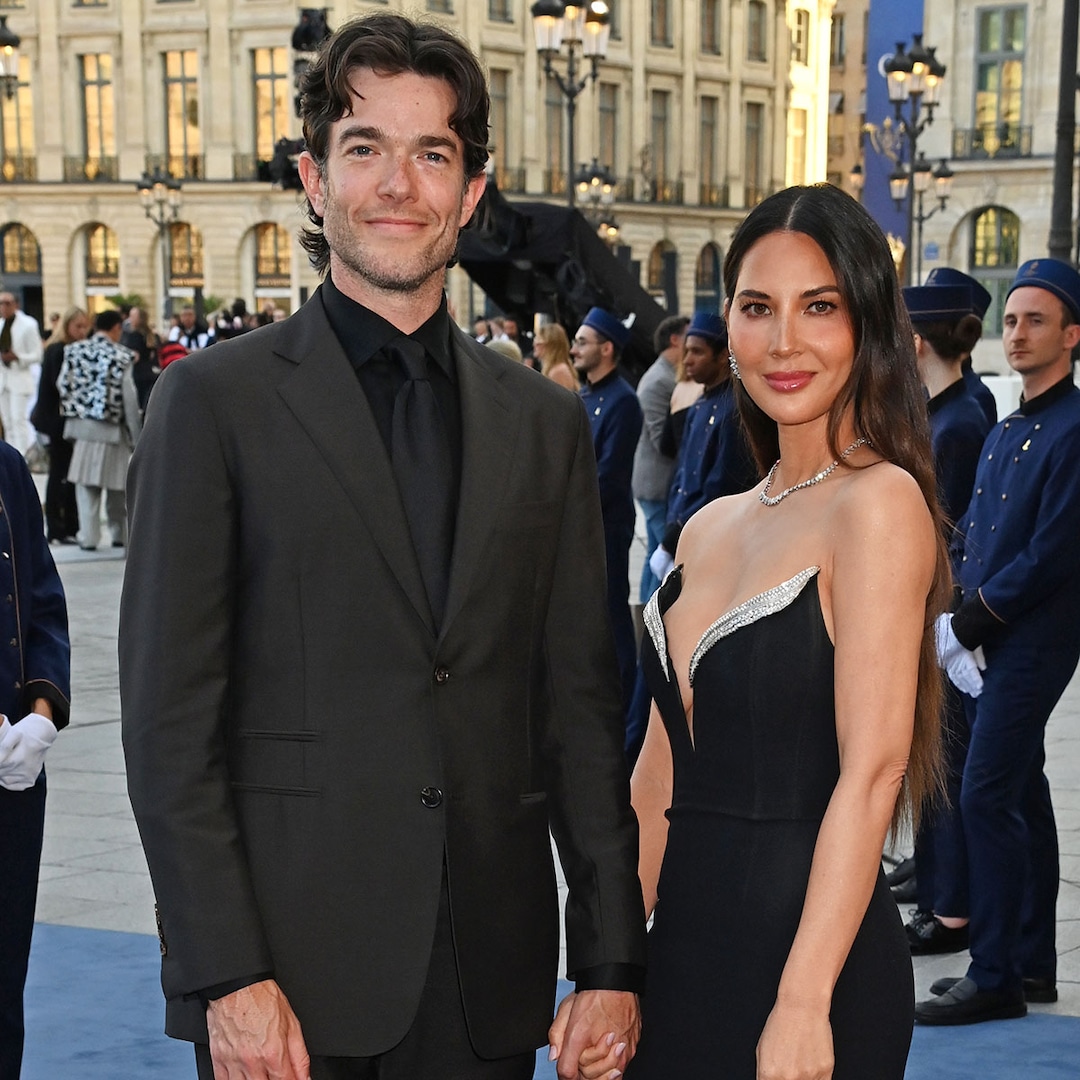
Secrecy and the Creation of “Nakedness” On Screen: Director Kristy Guevara-Flanagan and Producer Helen Hood Scheer on Their Documentary, Body Parts
Apr 21, 2023
Body Parts
In their documentary Body Parts, which premiered at Tribeca Film Festival in 2022 and is now streaming on digital platforms, director Kristy Guevara-Flanagan and producer Helen Hood Scheer confront issues of the male gaze and male supremacy within the film industry. The vastly informative film explores topics such as body doubling, beauty retouching in post, sexual harrassment on set and the introduction of intimacy coordination. Through candid interviews, an expansive array of archival footage and reenactments, this film thoroughly uncovers the darker history of sex on screen, also highlighting the ways in which tides are changing with more female filmmakers and perspectives now at the forefront.
Kristy Guevara-Flanagan is a documentary filmmaker who uses often experimental tactics to explore themes of gender and representation in pictures like Wonder Women! The Untold Story of Superheroines and Going on 13.. Her work has gained recognition and support from Tribeca, SXSW, and the Sundance Institute to name a few. Helen Hood Scheer is a documentary filmmaker and producer. Her short Apothecary won the gold medal Student Academy Award and her directorial debut, JUMP!, has been broadcast almost 250 times following its acquisition by Showtime. Last month I had the privilege of corresponding with both Guevara-Flanagan and Scheer over email about the conception of Body Parts, choosing archival footage, and establishing a comfortable environment for interviewees recounting often uncomfortable stories.
Filmmaker: You include such an eclectic group of film clips and references throughout. What was the process like of choosing these clips?
Guevara-Flanagan: Knowing that it would be time consuming and need a lot of revision and refining, we started the process of choosing clips early on. As the director, I started with the films that made the biggest impact on me growing up—like Fast Times at Ridgemont High, Porky’s and John Hughes’s films—and then expanded a lot from there. But we aimed to be inclusive; we wanted these clips to speak to people across generations, backgrounds and sexual orientation. We researched a lot, asked for recommendations, even crowdsourced on social media. As the film began to come together, it was a constant balancing act. We wanted to show the tropes and egregious patterns of sexual representation, but were also careful to not retraumatize and re-exploit women’s bodies. When were the images too titillating or too distracting? That often meant showing the least amount possible to convey our themes and make our point. We got a lot of feedback in the making of this film and really relied on how audiences were responding to that material to hone our edit. One of the most challenging scenes to edit was the one on the representation of sexual assault in film and TV. We tried to be very careful there, speaking to some of the history of the representation of rape on screen, but not punishing people in the audience in a way that felt like its own kind of assault.
Filmmaker: How did you go about financing this film? How were the archival clips licensed—I’m assuming they were used under the fair use, but perhaps not?
Scheer: For the first several years of production, Body Parts was funded on grants and a myriad of support from the universities we teach at. Kristy runs the MFA in documentary directing program at UCLA, and I spearhead the creative nonfiction track at California State University Long Beach. Sundance and California Humanities were our first supporters, followed by the Harnisch Foundation, Fork Films and the International Documentary Association’s Enterprise Fund. After we got into Tribeca, Level Forward came on board as equity funders and impact producers, Marian Godfrey/Ada’s Journey provided a grant and the DeNovo Initiative closed our gap with a recoupable grant.
All but two clips were used under the fair use exemption. We would not have made this film without having a strong sense of how it could be applicable in advance, and we also learned a lot in the process. There are two ways in which we employ fair use determinations in our film. When the clips are used “illustratively,” the connection between the clip and its use is very clear, giving an easy and strong fair use argument. This is the most common way filmmakers utilize the doctrine. Other times, Body Parts usage is more creative while still being within the threshold of fair uses’ safe harbor. In these instances, we had to do more to document why a clip was selected in relation to our film and also on plot and/or character context in the original source material. Given that there are nearly 1000 archival clips in the film, this was a huge amount of research and clearance work! Along the way, there were definitely clips that we had to replace because we could not adequately support them. Our fair use counsels, Lisa Callif and Madison Karsenty, were fantastic partners. The vetting process was extensive — we went through multiple rounds of review of the entire film and sub-sections. We all wanted to make sure that we were able to meet our larger artistic goals and also do it in a way that was defendable.
Filmmaker: What sparked your interest in pursuing this project and how did you seek out your collaborators?
Guevara-Flanagan: Body Parts was born from an earlier short I made about the trope of dead women in film and television. I had always been struck by the ubiquitousness of the dead woman on screen — fetishized or brutalized, but always lingered upon visually. What Happened to Her is a film made entirely from film and TV clips paired with an interview of an actor who had played a dead body. I was struck by the power of this pairing and its ability to speak to both what we see, its effects on audiences cumulatively, and how these images are made. Helen approached me to collaborate on my next project. Body Parts is a second short film in a tryptic about gender and representation on-screen.
Originally, we were interested in the performance of body doubles for nude and sex scenes. That these idealized bodies are brought in and stitched together to present a perfect image of feminine sexuality — while simultaneously being uncredited and paid less than stunt performers — was telling. Once we began to talk to actors, however, we realized there was so much more involved in the performing of sex scenes and nudity, and that the stakes were so high for those most often asked to take their clothes off: young women.
Nudity riders, modesty garments, merkins, deep fakes, and rape stunt coordinators? That so much negotiation and construction went into the creation of nakedness felt topical and urgent as an exploration of gender and its representation. In the midst of our research, Times Up and #MeToo exploded onto the scene and these very concerns became foregrounded in the news cycle. We followed the story and, five years later, here we are.
Scheer: We had a terrific team working with us. Our primary DPs, Frazer Bradshaw and Jason Joseffer, are experienced in all types of cinematography, from ads to indie features to corporate videos, and both also have directing experience. Their versatility, speed, and generosity of spirit made them ideal partners. A few other great DPs worked with us for one-to-two days, including Bryan Donnell, Jerry Henry, Guy Mossman, Alexandre Naufel and David Waldman. We worked with three phenomenal editors. Tova Goodman did the early heavy lifting, helping to sort through most of our interviews and initial archival tests; her efforts were key to keeping us engaged and on-track during the early months of the pandemic. Liz Kaar did the bulk of structural editing, leaving us a few weeks before birthing her second child. Anne Alvergue, recently nominated for an Oscar for the doc short The Martha Mitchell Effect, brought us home with story refinements and polishing; she has a lot of experience with archival films, which was invaluable. Knowing we wanted animation to be a part of the film early on, as one of our strategies was to not re-exploit the female body, we sought out advice and test animations from Kelly Gallagher very early; we are huge fans of her work, teaching approach, and radical spirit. She created the collage-style works for the film. Mindbomb Films did our titles, credits, and the majority of the film’s graphics; I’ve been a fan of their work since seeing them present at the International Documentary Association nearly 10 years ago. They ran with our ideas and also brought a lot of new ones to the table, including creating a Zoopraxis for our sequence on Muybridge. Our composer, Nainita Desai, is the only team member we didn’t know before starting this film; she was recommended by one of our EPs, Daniel Chalfen, and we think her work – vocals, drums, strings — perfectly encapsulates the emotional rollercoaster of emotions in the film. We hired emerging under-represented filmmakers in just about every other role, often bringing on our students and recent graduates for pay and on-screen credit.
Filmmaker: Were the reenactments always part of the plan? What felt important about including them with all of the stories shared in sit-down interviews?
Guevara-Flanagan and Scheer: Yes, the reenactments were always a part of the plan. We felt that reenactments would be a powerful way to share with audiences what it might feel and look like, from an actor’s perspective, to be on set and in the production process. We wanted to convey an intimate experience and visceral response, and think the hybrid texture and mood to help draw attention to the practice and artifice of filmmaking. It was also an opportunity to add diversity to the film. Finally, it was just fun to stretch our wings as documentary filmmakers.
Initially, we wanted to include more reenactments to help to provide a chronological arc to the film. How does a body double audition for her part? What does one “wear” to appear nude? What is it like to watch dailies of your nude self in a room full of people? Ultimately, we decided it was best for the film to include fewer of them, partially in an effort to make room for verite scenes that were not part of our initial plan.
Filmmaker: One moment that has stuck with me is Rosanna Arquette’s story about being essentially forced to remove her bikini top. I think this represents the normalization of discomfort and pressure on women, especially young women, in the presence of powerful men. What was important to you about keeping so much of this story in the final cut?
Guevara-Flanagan: It is true that Rosanna Arquette’s story was not uncommon to the kinds of stories that we would hear over and over again: the almost nonchalant or routinized ways in which young women were pressured or coerced in the presence of powerful men. It is also just one of the many ways throughout the production process in which women’s bodies could be exploited. While we were making a film where many characters were in dialogue with each other about their common experiences, we wanted to make sure to have moments where we could zoom in on individual stories and really hear what that experience was like from their point of view. Her story concludes the section on auditioning because she claims she was basically cast for her cleavage!
Filmmaker: There’s a running theme of secrecy throughout the film – body doubles, beauty work in post, even directors not being upfront about nudity. Could you elaborate on how secrecy has been normalized in the film business and the repercussions of that? Is this perhaps related to the way cinematic portrayal of sex translates into real-life sexual situations and dynamics?
Guevara-Flanagan and Scheer: This is such an important question. Hollywood treads in the illusion of reality so it’s no surprise that secrecy abounds and that the powers that be are vested in maintaining this secrecy. That’s a part of selling movie “magic” to audiences. But secrecy is also a way of maintaining power and re-enforcing inequities, like in terms of pay parity. And, unfortunately, as we have seen, NDAs allow predators to stay in business. The Speak Out Act, which prohibits the enforcement of pre-dispute NDAs or non-disparagement clauses regarding allegations of sexual harassment or assault, is a step forward but it doesn’t include post-dispute NDAs. Oversight in the entertainment industry is particularly difficult since there is no one governing HR type entity. Once a production is over, what real recourse does a complaint on a production have?
And yes, we hope Body Parts helps connect the dots between how women are represented on screen and how they are treated in the real world. Because film and television have become the most popular mechanisms through which we understand the world and our place in it — how we develop empathy for other people, learn about sexuality and consent (or lack thereof), see what women and girls can do and how they are expected to behave, etc. — the fact that women characters in film and television are so often nude, scantily clad, and less likely than men to be shown at work or with work-related goals in film and television is troubling and important. We appreciate the new wave of creators who are centering more authentic and diverse female experiences of sex and desire.
Filmmaker: How did you approach your interviews, which felt very organic, honest, and unfiltered? Given the discomfort of speaking about sex and sexuality touched on in the film, how did you navigate speaking about these topics and even triggering circumstances that the interviewees had endured?
Guevara-Flanagan: We tried to be very thoughtful and transparent in our interview process. I did pre-interviews with most participants, and to the best of our abilities, we let people know what we were interested in talking about and the scope of the interview. Sometimes that meant more than one conversation to feel out what felt right to them and how they could be critical without jeopardizing careers. We were also generally not “breaking” stories. Many of the women we spoke with had already come out in the press and had gone through a process of what that would mean to them personally. And we were generally not interested in naming names. That wasn’t really the point. We more wanted to hear about their experiences. We think that gave a lot of the people we interviewed license to speak more freely.
We also had the benefit of being a smaller crew as a documentary production. We filmed in a way where the director could always maintain eye contact with the interviewee. But yes, the interviews were emotional and sometimes difficult and often raw, especially when it was early in the process of speaking out. During the interview we took our time, we took breaks, we would stop and chat about what people were willing to say and not say. If anyone didn’t want to include what they had said, we honored that. It then became our responsibility to get the story right, to do these interviews justice, and to honor the vulnerability people shared. Most of the interviewees had an opportunity to see the film before we finalized the edit and discuss it with us. In hindsight, however, we do think differently now about retraumatizing people during the interview process. This is becoming a bigger part of the discussion in the documentary community and going forward we would think about strategies to be more supportive during an interview with therapeutic guidance.
Filmmaker: I feel that your film is incredibly inclusive and all-encompassing. How did you make sure your interviews and research covered all corners of the intimacy conversation in order to avoid exclusion? Were there any stories or perspectives you wish you had the time to include but couldn’t?
Guevara-Flanagan and Scheer: Well, thank you. We strived towards inclusivity early and throughout the process of making the film. We did a ton of research and tried to hit major plot points while connecting many dots between the films themselves, the labor behind them, and the way in which audiences receive these images. Early on, the feminist scholarship of Linda Williams was critical. She is one of the few theorists that wrote specifically about depictions of sex on screen and cited films that really pushed the envelope. We reached out to many people in the industry and there were a lot of “no”’s. We had to work with who we had access to despite wanting to be as diverse as possible. We shared the film with friends and colleagues to again, make it feel inclusive and encompassing.
There was certainly a lot of history of film material that was hard to corral within the scope of a feature film. And we didn’t want the film to be overly a survey film, a kind of listing of moments throughout cinematic history. They needed to be related to what the women in the film were speaking to today. But how did we get from here to there is an important part of the story. We may add a scene about femme fatales in the ’40s and ’80s, which will ideally replace the festival cut in most markets soon and also be used for educational distribution. We would have loved to include the way Maria Schneider was treated on the set of the making of Last Tango in Paris, in particular around the film’s rape scene. A story that does need to be told. But since Schneider has passed away, who could really tell her story?
Publisher: Source link
Every New Character Added To The MCU
Agatha All Along: Every New Character Added To The MCU Realizing that Wanda took all her power, Agatha's solution lies at the end of The Witches' Road, a series of trials that will reward those with what they are missing…
Oct 26, 2024
John Mulaney Shares Emotional Tribute to Wife Olivia Munn
"She shared her story to help anyone she could," John, who wed Olivia in July after three years together, continued. "According to the National Cancer Institute, in the week after Olivia shared the story of her breast cancer journey, there…
Oct 26, 2024
Eva Mendes Said There Have Been Times Where She’s “Regretted” Getting Cosmetic Work Done And Had To “Wait It Out”
Eva, who turned 50 this year, has previously said she would “never deny” getting cosmetic work done.View Entire Post › Disclaimer: This story is auto-aggregated by a computer program and has not been created or edited by filmibee.Publisher: Source link
Oct 25, 2024
Nicole Kidman Confirms Another Iconic AMC Ad Is “In the Making”
Nicole Kidman's 16-Year-Old Daughter Looks All Grown Up in Rare Public AppearanceWe come to this place for Practical Magic. At least, that’s a past role Nicole Kidman is channeling to tease that another AMC ad—like the movie theater chain’s original…
Oct 25, 2024










